Table of Contents
An email marketing funnel is a powerful tool that allows businesses to convert subscribers into customers through a series of strategically crafted emails. It is not enough to simply create a great product and hope that people will buy it. Instead, businesses need to make potential customers aware of their product, highlight the problems it can solve, and showcase the value they will miss out on if they do not make a purchase. This article will provide a comprehensive guide on how to build an effective email marketing funnel to drive conversions and boost revenue.
Why Do You Need an Email Marketing Funnel?
People do not typically buy a product or service as soon as they provide their email address. Instead, there are four major stages that subscribers go through before making a purchase:
-
Awareness: Once someone subscribes to your email list, they become aware of your brand’s presence and the solutions you offer.
-
Interest: Subscribers in this stage are actively engaged with your emails and are interested in learning more about your products or services.
-
Consideration: At this stage, potential buyers are evaluating their options and considering your offerings as a solution to their problems.
-
Conversion: This is the ultimate goal of your email marketing funnel, where a subscriber becomes a customer and makes a purchase.
To guide subscribers through these stages and maintain their engagement, an email marketing funnel is essential.
The 8 Types of Emails in a Sales Funnel
To effectively guide subscribers through the stages of the email marketing funnel, businesses need to send a sequence of carefully crafted emails. Here are the eight types of emails that make up a successful sales funnel:
1. Nurture Emails
The first step in the email marketing funnel is to send subscribers the content that you promised when they initially provided their email address. These emails should also include valuable content that positions you as an authority in your field.
2. Problem & Solution
In this email, you should address a common problem that your target audience faces and demonstrate how your product or service can solve that problem. It can be helpful to introduce a paradigm shift, highlighting a problem that people may not be aware of but that your product can address.
3. The Pitch
This email is where you formally introduce your product or service. Keep the message simple and straightforward, explaining the features and benefits in bullet points. The call-to-action (CTA) should be clear and direct, such as “Enroll,” “Add to Cart,” or “Buy Now.”
4. The Lift
If subscribers did not make a purchase after the pitch, this email provides additional value and gently reminds them about your product. The focus of this email should be on providing value, with a secondary mention of your product. Include multiple CTAs, such as text hyperlinks, to encourage clicks to the sales page.
5. Social Proof
This email is designed to build social proof and credibility. Include testimonials, case studies, and the number of people who have already purchased your product. Mention any awards or recognition your product has received to further build trust and encourage conversions.
6. The Objection Killer
At this stage, potential customers may have objections or questions about your product. Address these concerns in a Q&A-style email, organizing the questions from most to least concerning. Offer reassurances, such as a refund policy, trial period, or customer support access, to alleviate any doubts or objections.
7. The Close
In this email, you need to push subscribers to make a decision. Use a clear subject line that creates urgency, such as “Time to Decide” or “48 Hours Left Before the Cart Closes.” This email should bring together all the key elements of your product, including features, testimonials, guarantees, and more. Highlight what subscribers will miss out on if they do not invest in your product or service.
8. The Last Call
This is the final email in the sequence and reinforces the sense of scarcity. Use this email if you are taking pre-orders or have an upcoming course with limited seats. Keep the email short and clear, reminding subscribers of the deadline and creating a sense of urgency.
What Makes an Email Funnel Great?
To ensure the success of your email marketing funnel, there are several key elements to consider:
-
Understand the degree of awareness for each contact in your list. Segment your audience based on their level of familiarity with your brand and tailor your messaging accordingly.
-
Implement segmentation strategies to deliver personalized and targeted emails that resonate with your subscribers.
-
Infuse your brand’s personality and voice into your emails to create a connection with your audience.
-
Maintain high-quality email lists by regularly cleaning and updating your subscriber database.
-
Use persuasive sales copy in your emails, backed by high-quality content, to engage and convert subscribers into customers.
-
Continuously analyze and optimize your email marketing funnel based on data and feedback from your audience.
Conclusion
An email marketing funnel is a powerful tool for converting subscribers into customers. By strategically crafting a sequence of emails that guide subscribers through the stages of awareness, interest, consideration, and conversion, businesses can drive sales and boost their revenue. By incorporating personalization, segmentation, persuasive sales copy, and high-quality content, you can create an effective email marketing funnel that delivers results. So, start building your email marketing funnel today and watch your conversions soar.
